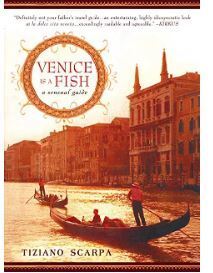
Venice is a fish: A sensual guide
By Tiziano Scarpa. Translated by Shaun Whiteside. Gotham Books, 2008, 160 pp.
Is there any city more written about than Venice? The city is "encrusted with imagination" writes Tiziano Scarpa. "There isn't another place in the world that could bear all that visionary tonnage on its shoulders." Venice, he says, "will sink under the weight of all the visions, fantasies, stories, characters and daydreams it has inspired."
Scarpa nonetheless seems quite happy to add to that "tonnage" in this love letter to his native city. His "sensual guide" addresses ways the visitor can take Venice in through the senses and is organized around various parts of the body.
Under "feet," for example, he says: "Feel how your toes turn prehensile on the steps of the bridges, clutching at worn or squared edges as you climb…Wear light shoes, soft-soled…" Under "legs," he observes, "You're forever going up and down, even in the calli.: Venice is never flat, it's a continuous unevenness, all lumps, bumps, hump-backed bulges, dips, dents, depressions…" Heart disease is not a problem in Venice, he remarks.
As these quotes suggest, this is a very playful book. "Heart" leads to a discussion of where, in a city without cars, youngsters can find a place to make love when their parents are home. Read More








